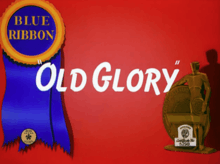Old Glory (film)
Old Glory is a 1939 Warner Bros. Merrie Melodies animated cartoon directed by Chuck Jones.[1] The short was released on July 1, 1939, and stars Porky Pig.[2]
| Old Glory | |
|---|---|
 | |
| Directed by | Charles Jones |
| Produced by | Leon Schlesinger |
| Story by | Robert Givens Richard Hogan Dave Monahan |
| Starring | Mel Blanc John Deering John Litel Tedd Pierce Shepperd Strudwick |
| Music by | Carl Stalling |
| Animation by | Robert McKimson |
| Color process | Technicolor |
Production company | |
| Distributed by | Warner Bros. Pictures The Vitaphone Corporation |
Release date | July 1, 1939 (original) August 25, 1945 (Blue Ribbon reissue) |
Running time | 9:03 |
| Language | English |
Plot
Porky Pig attempts to learn the Pledge of Allegiance but becomes bored and falls asleep. In his dream, Uncle Sam (voiced by John Deering)[3] comes to life and teaches Porky about history from Colonial America through the midnight ride of Paul Revere (voiced by Shepperd Strudwick) and the American Revolutionary War to the expansion of the American Old West, briefly alluding to Abraham Lincoln. Upon awakening, Porky snaps into a salute and recites the pledge as the Flag of the United States waves overhead.
Production notes
The animation in Old Glory is realistic and heavily rotoscoped, different from the usual Warner Bros. style. Director Chuck Jones was known for his Disney-like style during this period, and Schlesinger assigned him to make this cartoon for that reason. The scene with Patrick Henry (voiced by John Litel) saying his "Give Me Liberty" speech was rotoscoped from the Warner Bros. color 2-reel historical short, Give Me Liberty. That short won the Academy Award for Best Short Subject - Color of 1936. Also rotoscoped were scenes from the live-action short Declaration of Independence (1938).[4]
There were many different tones of colored inks used on the film. Uncle Sam has different tones on his hat, beard, face, and clothes. All the other characters were treated in a similar manner. There were many cels depicting the Flag of the United States in its stars and stripes.[4]
The film was produced during a heat wave in Los Angeles. Due to the lack of air conditioning at the studio, the production staff initially relied on two large fans to keep cool. They had to be pointed at the ceiling so that they did not blow cels and drawings across the room. Eventually production moved to night time, since the temperature dropped at night.[4]
Most Leon Schlesinger animated shorts were first screened at the Warner Bros. Theater at the Hollywood Boulevard. This film was instead screened at the more prestigious Carthay Circle Theatre. All animation studio employees were invited to attend.[4] The film was screened alongside the live-action Dark Victory.[4]
Legacy
The original ending was cut when the cartoon was reissued as a Blue Ribbon Merrie Melodies short, in 1945 and 1953. A version with a restored ending can be found on the Looney Tunes Golden Collection: Volume 2, Looney Tunes Platinum Collection: Volume 1 and Porky Pig 101. This copy retains the Blue Ribbon opening, as well as the original opening shot of the flag and its music cue.
Old Glory is Jones's first short to feature Porky Pig. It is also Porky's first appearance in a color Merrie Melodies entry since his debut in 1935's I Haven't Got a Hat, and his first short in three-strip Technicolor.[5]
During the late 1960s, Old Glory was regularly screened between rock acts at The Fillmore in San Francisco. Many of the Fillmore's patrons drew great amusement from a pig saluting the American flag, as "pig" in 1960s slang was a derogatory term for a police officer and his saluting the flag was a symbol of the kind of America most people were against at the time.[6]
References
- Beck, Jerry; Friedwald, Will (1989). Looney Tunes and Merrie Melodies: A Complete Illustrated Guide to the Warner Bros. Cartoons. Henry Holt and Co. p. 89. ISBN 0-8050-0894-2.
- Lenburg, Jeff (1999). The Encyclopedia of Animated Cartoons. Checkmark Books. pp. 124–126. ISBN 0-8160-3831-7. Retrieved 6 June 2020.
- "John Deering". IMDb.
- Sigall (2005), p. 58-59
- Beck, Jerry, editor. The 100 Greatest Looney Tunes Cartoons. San Rafael, CA: Insight Editions. p. 122.
- Beck, p. 124.
Sources
- Sigall, Martha (2005). "The Boys of Termite Terrace". Living Life Inside the Lines: Tales from the Golden Age of Animation. University Press of Mississippi. ISBN 9781578067497.